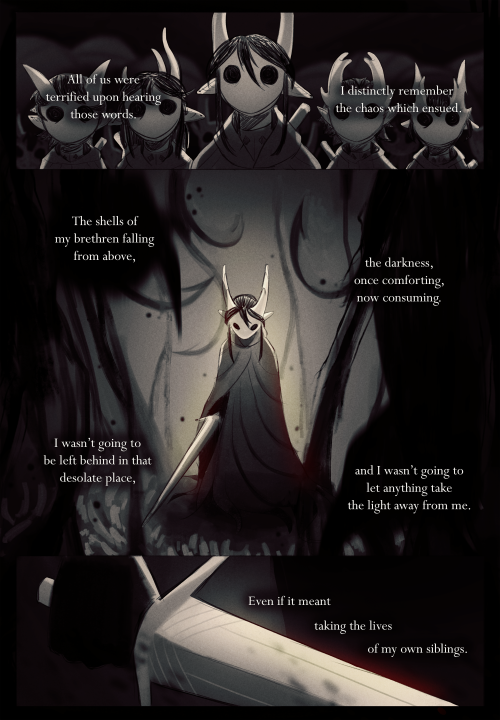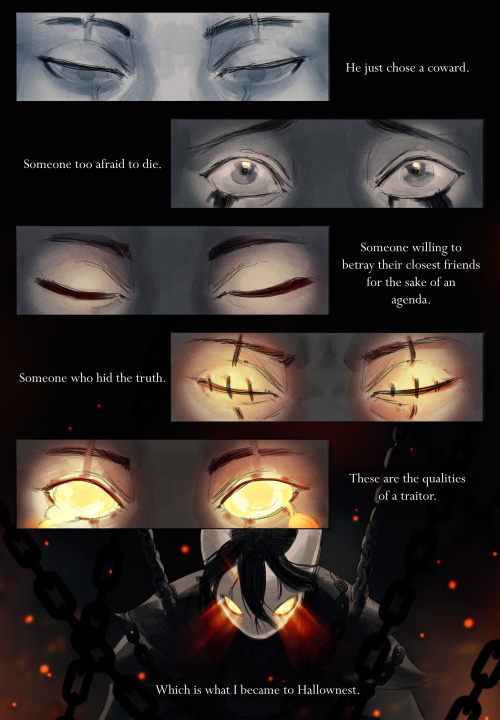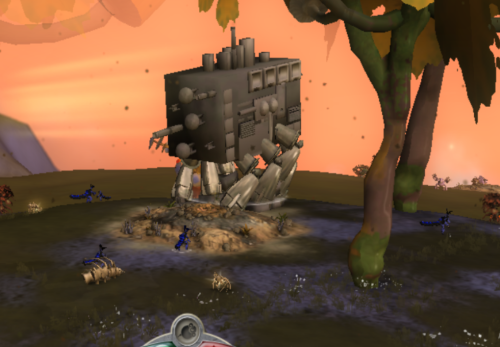Draw Your Babygirl Like This
draw your babygirl like this

More Posts from Musical-fish and Others
Your friend requested to be buried with his headset and system, he just came online.








survive - minicomic
Warning ahead of time for talking about aquatic animal death (non-mammal), trying not to talk about food preparation (I think I did good not mentioning specific things), and non-aquatic animal death.
I like watching food videos, which is great and all until it's seafood. It's either going to be palatable to watch or activate discomfort and rage.
The only way I can watch them is if the meat is already prepared, as they should be. Except shellfish (I feel so dumb asking, but that's shrimp as well, yeah? I think yeah).
But, like, there are! So many! Videos! Preparing the seafood Too Much! One was even taking a fish straight from a river and preparing it for eating! You get what I mean? I don't want to say too much.
And because of your efforts in spreading the truth of fish (and other aquatic non-mammals) having feelings and personalities and such, I start thinking... Would there be casual videos of food preparation like this for chickens? Cows? No, no there wouldn't. Because we respect them to some kind of degree, their full preparation would be greatly distressing to watch, wouldn't it? Why is it okay with seafood? You get me?
Not to worry anon, I will tag this appropriately with animal death trigger warning tags. Though I will also have to warn anyone still reading, I will also talk about the killing of animals. A bit of an essay about fish mistreatment and the possible reasons why incoming ^^''
I feel you! I have noticed this worrying trend in society myself, so have many other much wiser fish enthusiasts and activists before me. Publicly showing the preparing of fish from the live animal to the finished dish is... creepily normalised. Especially when this would never be done to mammals! Like that pufferfish meme that was popular some years back, the one where the pufferfish eats a carrot and then moans? That clip is a part of a fuller video where said pufferfish is prepared, fully on screen, into a dish. Even the actual meme, the pufferfish biting into the carrot and moaning is saddening and disturbing to me; the pufferfish is gasping for oxygen and the chef sticks a carrot in its mouth just to show how sharp its beak is, prolonging its fear and suffering.
Something that I think explains this phenomenon, and what I've heard activists talk about, is that what most dictates how we view an animal is how we first come into contact with said animal. We tend to see animals like mammals, birds, beautiful pollinators in everyday life in contexts that tend to value them just for existing as they are, like dogs and cats being pets, songbirds singing and butterflies and bees flying from flower to flower looking pretty. (As a big arthropod fan I acknowledge that invertebrates are often overlooked and underestimated as well! And I also acknowledge that not all mammals and birds are loved equally as they should. But that's a whole other story.)
But fish? Besides aquariums, I don't think people have very many experiences with fish just existing. Many people's first real memory of seeing and interacting with fish might just be going fishing with a relative or a friend. Your first meaningful encounter with a fish and it's said fish being caught with a hook in the lip, out of the water, possibly suffocating or promptly killed to be prepared into a dish? That kind of interaction immediately normalises that fish are more of a service than a group of animals that can be appreciated just as they are. It also normalises catching and preparing of fish unlike any other animal! I'm not saying fishing is inherently horrible, but see how most people don't ever get to see a cow or a chicken being slaughtered? Yet a good chunk of people must have gone fishing at some point or another. This immediately and subconsciously tells us that it's fine to see fish being killed in front of us, because it's normal.
I think what also helps us disregard the emotions and experiences of fish when we see them be killed in front of our eyes is the fact that, as humans, we can have a hard time relating to animals that don't look or emote like we do. Of course fish feel emotions, they feel joy, sadness, anger, love, and they definitely feel terrified to be out of the water and in the hands of a predator! But they don't emote it through facial expressions, they can't scream or wail, they can't wave their limbs like a terrestrial animal in distress would, they can only squirm. The emotions they feel are real, we just don't read them as strongly as we do on other animals. (And even then humans are mighty good at anthropomorphising animals when they shouldn't. Did you know that to other primates smiling is often a threat display, but some humans have gotten hurt by primates for assuming that it's a happy smile and smiling back?) So, once again we can ignore the feelings of fish much easier when they aren't screaming in fear, or crying, or clawing to get out — out of sight, out of mind. This is most likely why some folk think of fish as living decorations, also. It's easy to overlook their personalities when you don't see them displaying their emotions loud and clear.
These two reasons are why I think it's extraordinarily important to teach people about the lives of fish! Sure, fishing will always be a thing and our tendency to look for humanlike expressions is in our DNA. But how easy will it be to disregard fish once you know that cichlids form complex social circles where everyone knows who's who and their exact relationships? How manta rays and cleaner wrasse recognise their own self in a mirror and even in pictures? How catfish talk to each other with drumming sounds? How bettas have unique personalities and enjoy playing? How some sharks like to be pet? I don't think it'll come just as naturally as before. Even one visit to an aquarium or a near body of water can be a lifechanging experience. :)
Thank you anon for presenting such an interesting ask, look how it got me talking! This is all food for thought, for me and to anyone who has gotten this far. I don't think I can ever express how much I love fish. I love their little personalities so much and they all deserve to live their lives to the fullest. I hope that perhaps some people who didn't see it before will be able to see what I see, because life is so much more fun and meaningful when you appreciate all the living things around you! Not just the meowing and barking ones.
Trying to prove a point to my transphobic parents
Reblog if trans men are REAL, VALID AND HANDSOME MEN, NO MATTER HOW THEY CHOOSE TO PASS
Reblog if trans women are REAL, VALID, AND BEAUTIFUL WOMEN, NO MATTER HOW THEY CHOOSE TO PASS
And finally, because it's a part of my argument for this point, and also because they are,
Reblog if nonbinary and genderqueer people in general, are REAL, VALID, AND GORGEOUS PEOPLE, NO MATTER HOW THEY PASS
Gather round, children, and let me tell you the tale of the sturddlefish. In the year 2019 in the mythical land of Hungary’s Research Institute for Fisheries and Aquaculture, some scientists were trying to save some endangered fish. The Russian sturgeon and American paddlefish are distantly related species that are both endangered. The scientists were trying to induce gynogenesis in the sturgeon.
This is a type of parthenogenesis (single parent reproduction) where sperm triggers the embryo growth, but doesn’t contribute genetic material. In any type of parthenogenesis, the offspring is basically a clone of the mother.
The scientists needed to have sperm interact with the eggs without inseminating them. So they used paddlefish sperm. Since paddlefish diverged from sturgeons 184 million years ago, the scientists figured that there was no chance of insemination.
Much to their surprise, the paddlefish sperm did fertilize the sturgeon eggs, creating the hybrid sturddlefish. This was not expected at all due to his distantly related the parent species are. There were two sturddlefish populations from the same breeding. One that was 50% sturgeon and paddlefish and one that had twice as much sturgeon due to chromosome doubling. Only about 2/3 of the sturddlefish survived longer than a month and only about 100 survived past a year. Hybrids often have health problems that limit their lifespans. Given how long-lived the parent species are, a healthy sturddlefish could live for a long time.
The sturddlefish will live out their lives in the research institute and the scientists have no plans of making more. I don’t know if any of them are still alive. For a brief time, a new lifeform will have come into existence by sheer accident and will soon be extinct. May they Rest In Peace
Image from a to d: Russian sturgeon, mostly sturgeon hybrid, even hybrid, American paddlefish

i love AI characters in media!!!!! its so interesting to see how humans invision what an artificial human would act like!! we barely even know ourselves, but we imagine the minds we could create!!! do robots have morals? emotions? fears? do they dream? can they love? give me all of it !!!!!!!
-
 tsf99 reblogged this · 1 month ago
tsf99 reblogged this · 1 month ago -
 faggling liked this · 1 month ago
faggling liked this · 1 month ago -
 hclxn liked this · 6 months ago
hclxn liked this · 6 months ago -
 fleur-d-or liked this · 6 months ago
fleur-d-or liked this · 6 months ago -
 kissyghost liked this · 6 months ago
kissyghost liked this · 6 months ago -
 holycoffeepersona reblogged this · 8 months ago
holycoffeepersona reblogged this · 8 months ago -
 normystical liked this · 9 months ago
normystical liked this · 9 months ago -
 slabime liked this · 9 months ago
slabime liked this · 9 months ago -
 snixx liked this · 10 months ago
snixx liked this · 10 months ago -
 goobybro reblogged this · 10 months ago
goobybro reblogged this · 10 months ago -
 kyvbey liked this · 11 months ago
kyvbey liked this · 11 months ago -
 christinakratt liked this · 1 year ago
christinakratt liked this · 1 year ago -
 okamiden-holiday-special liked this · 1 year ago
okamiden-holiday-special liked this · 1 year ago -
 cullrose reblogged this · 1 year ago
cullrose reblogged this · 1 year ago -
 no-no-no-no-6 liked this · 1 year ago
no-no-no-no-6 liked this · 1 year ago -
 timedrag reblogged this · 1 year ago
timedrag reblogged this · 1 year ago -
 timedrag liked this · 1 year ago
timedrag liked this · 1 year ago -
 eye-searing reblogged this · 1 year ago
eye-searing reblogged this · 1 year ago -
 winsday09 reblogged this · 1 year ago
winsday09 reblogged this · 1 year ago -
 l3fan reblogged this · 1 year ago
l3fan reblogged this · 1 year ago -
 l3fan liked this · 1 year ago
l3fan liked this · 1 year ago -
 mooshuuuuus reblogged this · 1 year ago
mooshuuuuus reblogged this · 1 year ago -
 mooshuuuuus liked this · 1 year ago
mooshuuuuus liked this · 1 year ago -
 flaming-orca-lilly reblogged this · 1 year ago
flaming-orca-lilly reblogged this · 1 year ago -
 flaming-orca-lilly liked this · 1 year ago
flaming-orca-lilly liked this · 1 year ago -
 herbal--fuckery reblogged this · 1 year ago
herbal--fuckery reblogged this · 1 year ago -
 tamahinebthicc liked this · 1 year ago
tamahinebthicc liked this · 1 year ago -
 my-catsface liked this · 1 year ago
my-catsface liked this · 1 year ago -
 ohdeergood liked this · 1 year ago
ohdeergood liked this · 1 year ago -
 geftheshittalkingmongoose reblogged this · 1 year ago
geftheshittalkingmongoose reblogged this · 1 year ago -
 crunchloops reblogged this · 1 year ago
crunchloops reblogged this · 1 year ago -
 crunchloops liked this · 1 year ago
crunchloops liked this · 1 year ago -
 amoniccrow liked this · 1 year ago
amoniccrow liked this · 1 year ago -
 mocharoni liked this · 1 year ago
mocharoni liked this · 1 year ago -
 hopefulharpy liked this · 1 year ago
hopefulharpy liked this · 1 year ago -
 suspiciousjam liked this · 1 year ago
suspiciousjam liked this · 1 year ago -
 baomim liked this · 1 year ago
baomim liked this · 1 year ago -
 pom-druzy liked this · 1 year ago
pom-druzy liked this · 1 year ago -
 trash-eating reblogged this · 1 year ago
trash-eating reblogged this · 1 year ago -
 sirstrawberryhead liked this · 1 year ago
sirstrawberryhead liked this · 1 year ago -
 goatingale reblogged this · 1 year ago
goatingale reblogged this · 1 year ago -
 goatingale liked this · 1 year ago
goatingale liked this · 1 year ago -
 cheesuschrist-iii liked this · 1 year ago
cheesuschrist-iii liked this · 1 year ago -
 beevean liked this · 1 year ago
beevean liked this · 1 year ago












